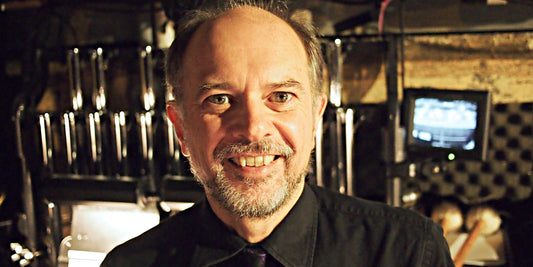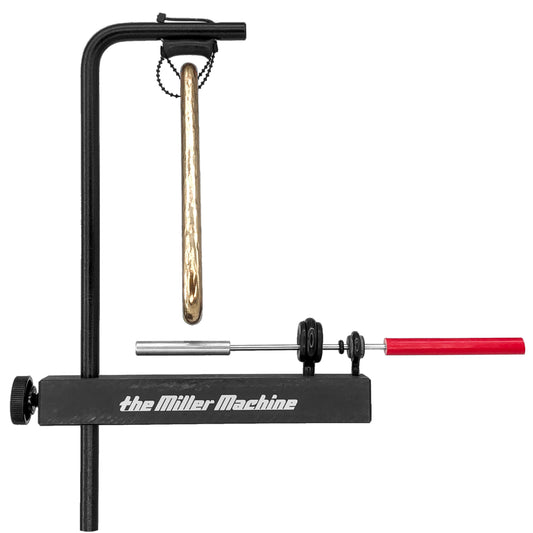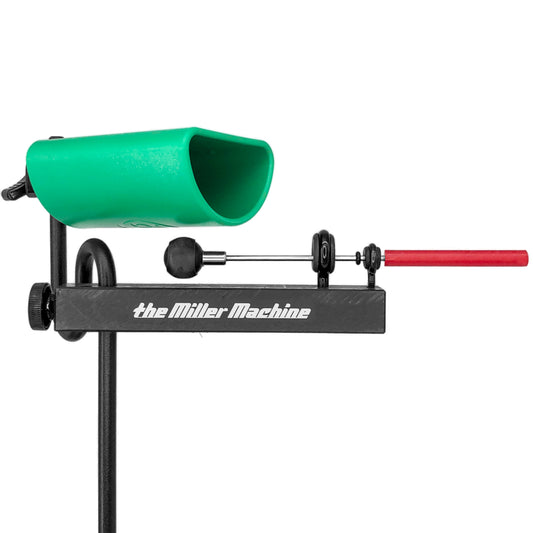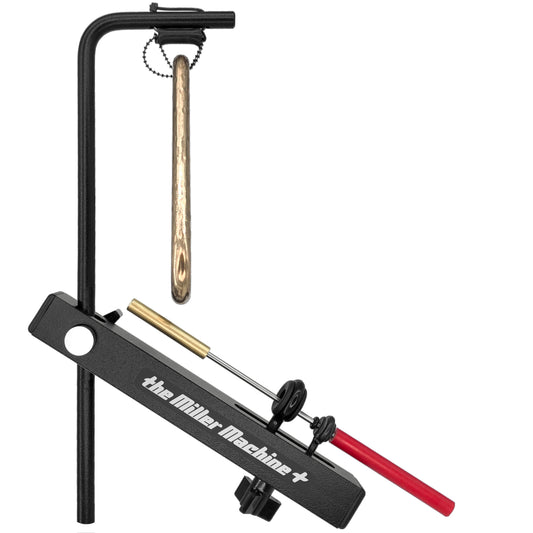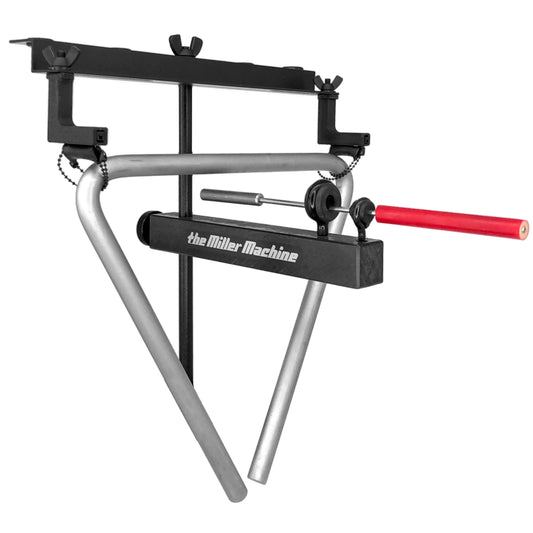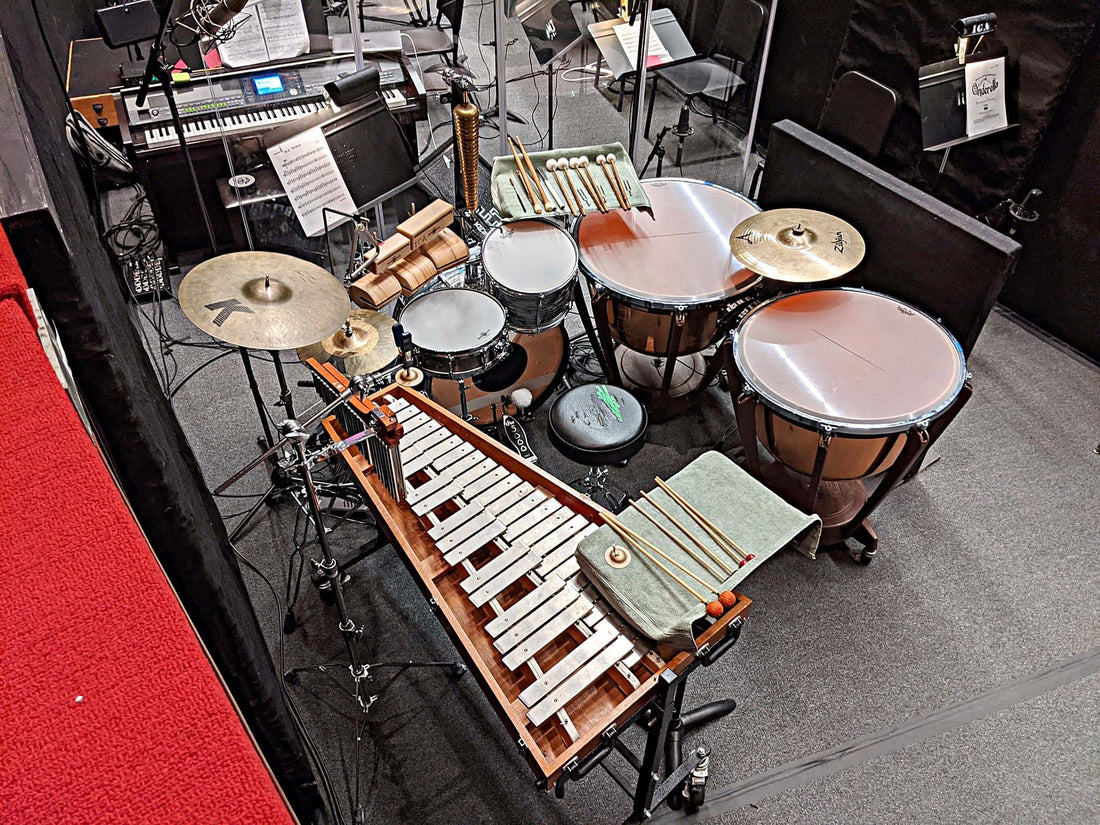
Cinderella - Austin Shoupe
Austin Shoupe's setup for Cinderella: Enhanced Edition at the Corson Auditorium in Interlochen, Michigan.
Write-up below photos.








Below: Older Ludwig 24" Kick Drum with Vic Firth VicKick Fleece Beater.


Below: Home-made swizzles made from a pair of Innovative Percussion's Chris Lamb Model #2.




"Ultimately this is a Rodgers and Hammerstein production. However, from what I’ve gathered it is a stage adaptation of a TV adaptation of another TV adaptation of the Broadway production. I could have missed a detail in there somewhere. The important thing is the acoustic percussion set up is much smaller than other versions of R+H Cinderella’s: no xylophone, no rubber udders, no drumset player.
This particular production is being put on by the Interlochen Summer Arts Camp’s high school music theatre division. The crew and orchestra are largely comprised of professionals and camp staff while the cast is composed of some of the country’s most talented high school performers. Thanks to the high level of vaccination among staff and students, we can stage a full-size musical production inside the wonderfully brutalist Corson Auditorium, the premiere performance space at the Interlochen Center for the Arts (ICA). Given this venue, I have access to incredible gear.
The equipment is a mixture of my own personal items and ICA’s phenomenal instruments. I do have to work around the needs over various student ensembles around campus but, since I’m inside and they’re not, I ended up with some of the nicest equipment.
The heart of the setup is the trap kit: kick, snare, hat, and floor tom. The music more closely resembles concert band parts than they do drumset, so I selected an older Ludwig 24” kick drum I had recently restored to playing condition and paired it with my own personal Black Swamp Percussion's (BSP) 14"x4” titanium SoundArt snare drum. The big kick, with a Remo CS batter and Felt Tone Resonant Head, has a very concert bass like sound that carries through the heavy concrete walls with ease despite being very brittle sounding from the throne. The snare tolerates a fairly low note for its size. The natural spread of BSP drums keeps the snare from sounding too thin when playing time.
Over the kick is a rack tom and a bell tree. Both are mounted via the tom mount on the kick. The score asks for a floor tom, but the instrument is used infrequently and only as a contrast to the snare drum. The rack tom makes switching to the timpani much easier. The rig above the snare contains a Grover Super Overtone Triangle mounted with a home-made mount (inspired by The Miller Machine Triangle Arm), two BSP woodblocks, and three BSP steam bent temple blocks. These are all mounted into an LP Everything Rack, which is rotated to level the playing zones on the temple blocks a touch.
To the left is a Fall Creek K100W glockenspiel with a bizarre folding mark tree from LP and a Zildjian finger cymbal. The Fall Creek is amazing, but the wide bars, extended range, and stand all make the set up more cluttered than it needs to be. Haven’t found a good place for my left foot yet as there is a caster taking up the best spots. To the right are the 26” and 29” Yamaha 6300 series timpani. For cymbals, I have an 18” K Custom Dark Crash as a suspended, a pair of 13” K Custom Hybrid hats (bottom on top for a fuller sound), and an 18” A Custom Medium Crash for moments that need more shimmer or impact.
My implement choices were pretty limited given that the camp is eight hours from home. They include some standard fare like Tim Genis timpani mallets (Gens 5, 6, and 7) and AA30s from Innovative Percussion (IP). The brushes are Vic Firth’s Jazz brushes for the increased volume potential. Glock mallets are the KBLs and K15s from Freer. The two standouts are the VicKick Fleece Beater (which my wife packed up and mailed on extremely short notice) and some home-made swizzles. The VicKick really takes the concert bass drum vibe all the way home and has been the best beater for drawing out a low sound from a shallow drum. The swizzles are made from IP’s CL-2Ls, which has a greatly underrated cymbal sound. The butts were sanded and covered with 1/2" latex tubing which was then covered with chamois. The result is a bigger version of the IP-JM2s on the butts which provides an amazing temple block sound and passing timpani sound.
This might be the most playable and easy to navigate setup I’ve played in a musical. The only awkward problem is the need to change pitches on the timpani while keeping time with the bass drum and snare. This leads to some strange moments where I need to switch which foot plays the bass drum so I can keep time while retuning timpani. The alternative would have been to place the timpani on the left, but the part has plenty of interjections on the 29” that then end up being too far behind me. It also places most of the glockenspiel playing further away from the snare as well. The part contains several extremely nasty instrument changes, like releasing a snare drum roll into a triangle, Mark Tree, or timpano. Keeping things close is important here."
Austin Shoupe is currently a DMA candidate and teaching assistant at the University of Kentucky. Previously, he has been a high school instrumental music teacher, freelance percussion instructor, and freelance musician in the Chicagoland area.
Cinderella - Regional - Austin Shoupe
August 2021



